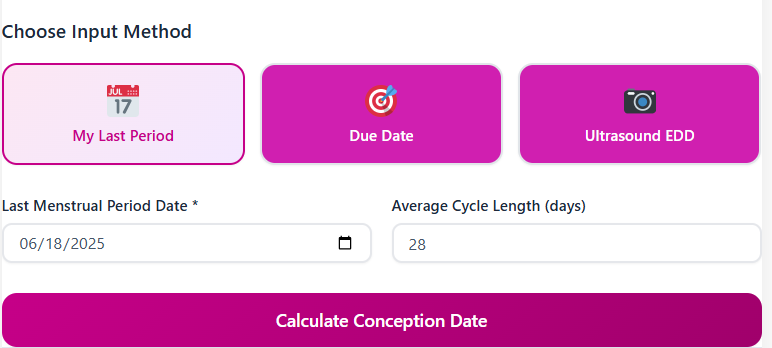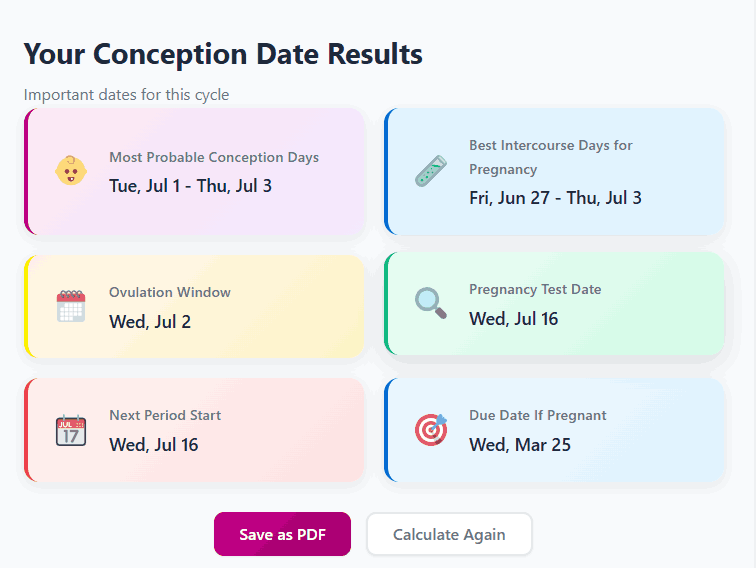Conception Date Calculator
Find your most probable conception date and fertility window using your cycle data. Accurate predictions for pregnancy planning and tracking.
Choose Input Method
The Pregnancy Timeline: A Gynecologist’s In-Depth Guide to the Conception Date Calculator
Foreword by Dr. Anuja Dokras, MBBS, DNB (Obs & Gynae)
In my years of experience as an Obstetrician and Gynecologist, I’ve seen how technology has empowered prospective parents. Tools like online calculators provide instant access to information. However, there’s a crucial difference between information and knowledge. A calculator can give you a date, but why that date is clinically significant, the biology behind it, and what happens when the numbers don’t match your reality—that is true knowledge.
This guide is designed to provide you with that knowledge. We will use this “Conception Date Calculator” as a starting point, but we will delve much deeper. We’ll discuss the incredible biological process happening inside your body, the clinical importance of each key milestone, and how you can use this information to navigate your pregnancy journey with confidence.

Section 1: The Clinical Significance of Accurate Dates
First, it’s vital to understand why we doctors care so much about these dates. It’s not just about knowing your delivery date. An accurate gestational age (the number of weeks since conception) is the cornerstone of your entire antenatal care.
- Accurate Assessment of Fetal Growth: We use gestational age to determine if your baby is growing as expected. If there’s a discrepancy, it allows us to investigate underlying issues early.
- Timing of Critical Screenings and Tests: Many tests during pregnancy are time-sensitive:
- NT (Nuchal Translucency) Scan: This screening for chromosomal abnormalities like Down syndrome must be performed between 11 and 14 weeks.
- Anomaly Scan (TIFFA): This detailed ultrasound is done between 18 and 22 weeks to check the baby’s anatomy.
- Gestational Diabetes Screening: This typically occurs around 24 to 28 weeks.
Incorrect dates can lead to missing the window for these crucial tests.
- Management of High-Risk Pregnancies: In conditions like high blood pressure or diabetes, accurate gestational age helps us decide the best time for a safe delivery.
- Avoiding Unnecessary Interventions: A pregnancy is considered “post-term” after 40 weeks. Accurate dating helps us avoid inducing labor unnecessarily unless it is medically required.
Section 2: The Science Behind the Calendar – A Biological Journey
Let’s understand the biological events that this calculator attempts to measure.
- The Menstrual Cycle and Ovulation: Your cycle begins on the first day of your last menstrual period (LMP). About 12-16 days later, a mature egg is released from your ovary—a process called ovulation.
Dr. Anuja’s Comment: “The ‘Ovulation Window’ result from the calculator estimates this event. It is the key to your most fertile period.”
- Fertilization: After ovulation, the egg travels into the fallopian tube where it remains viable for about 12-24 hours. If sperm are present during this time, fertilization can occur.
Dr. Anuja’s Comment: “The ‘Most Probable Conception Days’ on the calculator is the 24-48 hour window where this magical moment is most likely to happen. However, remember that sperm can survive in your body for up to 5 days, which is why the ‘Best Intercourse Days’ window is longer.”
- Implantation: The fertilized egg, now called a zygote, begins its journey to the uterus, which takes about 6-12 days. When it embeds itself in the uterine lining, this is called implantation.
Dr. Anuja’s Comment: “Implantation is a critical step! This is when your body starts producing the pregnancy hormone, hCG (human Chorionic Gonadotropin). The ‘Pregnancy Test Date’ from the calculator estimates the day when hCG levels in your urine will be high enough to be reliably detected by a home test.”

Section 3: Understanding Your Results – A Detailed Analysis
- Due Date: This is 280 days or 40 weeks from your LMP.
- Expert Insight: It’s interesting to note that only about 5% of babies are born on their exact due date! A full-term pregnancy is considered anywhere between 37 and 42 weeks. Think of your due date more as a “due week.”
- Pregnancy Test Date:
- Expert Insight: Testing too early can lead to a “false negative” result because hCG levels have not built up enough yet. Be patient and wait until the suggested date. If you miss your period and the test is negative, try again in a few days or see your doctor for a blood test.
Section 4: Beyond the Numbers – When Calculators Aren’t Enough
This calculator is a powerful tool, but it has its limitations. As a physician, I frequently encounter situations where standard calculations do not apply.
- Irregular Menstrual Cycles: If your cycle length varies each month, the LMP method becomes unreliable. Ovulation may not happen on day 14.
- PCOS (Polycystic Ovary Syndrome): Women with PCOS often have irregular or anovulatory (without ovulation) cycles, making standard calculators nearly useless.
- Recently Stopping Contraception: It can take a few months for your body to re-establish its natural cycle after stopping hormonal contraception (like the pill).
- Breastfeeding: Breastfeeding can suppress ovulation, making cycles unpredictable.
Dr. Anuja’s Advice: “If you fall into any of these categories, do not be discouraged. Use the calculator as a very rough estimate, but focus on more reliable methods like Ovulation Predictor Kits (OPKs), Basal Body Temperature (BBT) charting, and most importantly, consult your gynecologist for guidance.”
Q&A – Dr. Anuja Dokras
Final Words: Balancing Technology and Personalized Care
This Conception Date Calculator is a fantastic, informative tool to begin your pregnancy journey. It educates you about your body and gives you a framework for planning.
However, do not let it be the sole guide on your journey. Your body is unique. My job as your healthcare provider is to interpret these numbers, tailor advice to your individual health needs, and ensure that you and your baby remain safe and healthy.
Use this tool wisely, and remember to partner with your doctor for your personalized medical journey.
Dr. Anuja Dokras, MBBS, DNB (Obs & Gynae)
